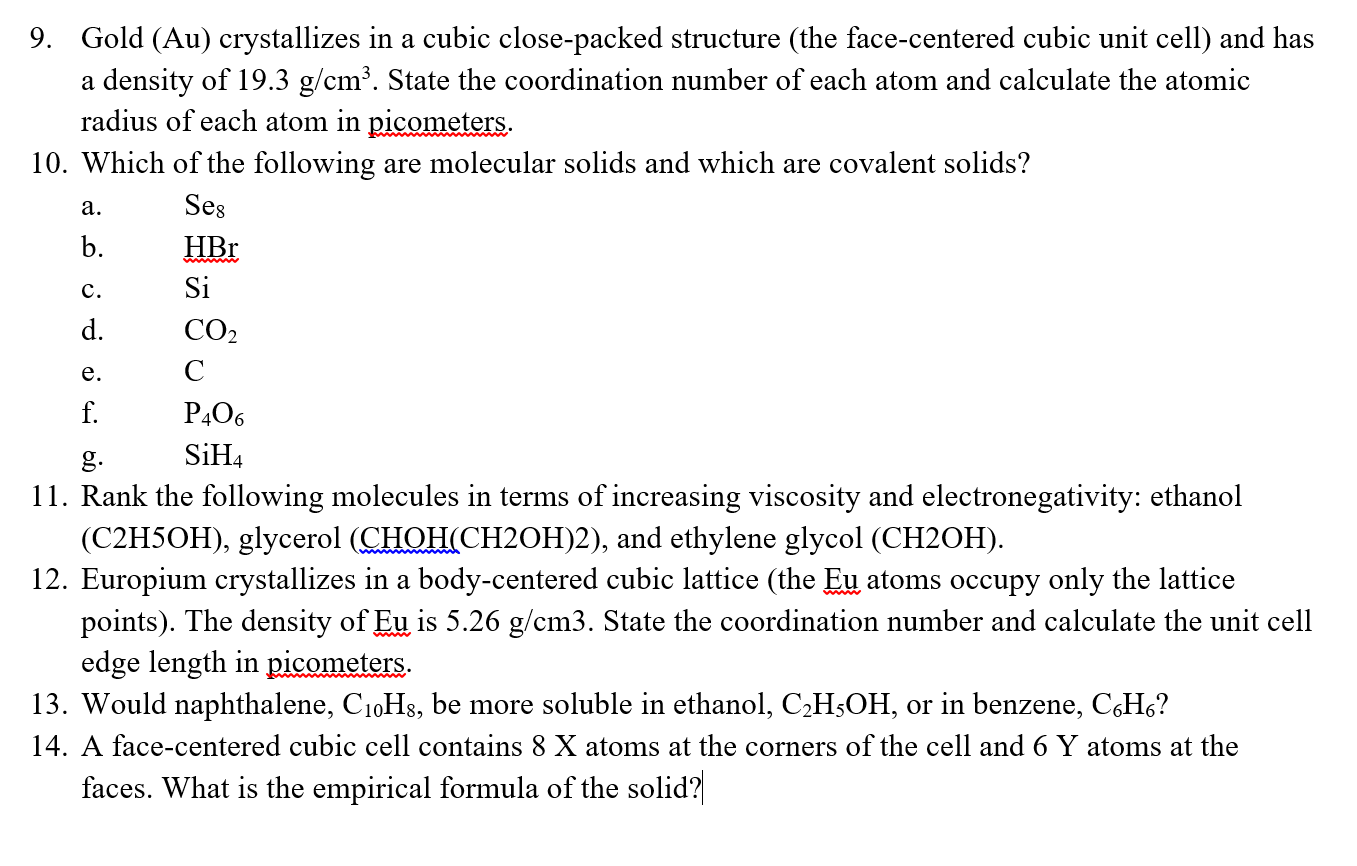Gold (Au) crystallizes in a cubic close-packed structure (the face-centered cubic unit cell) and has a density of 19.3 g/cm3. State the coordination number of each atom and calculate the atomic radius of each atom in picometers. 9. 10. Which of the following are molecular solids and which are covalent solids? Ses a. b. HBr C. d. CO2 e. C f. Si P406 g. SiH (C2H5OH), glycerol (CHOH CH20H)2), and ethylene glycol (CH20H). points). The density of Eu is 5.26 g/cm3. State the coordination number and calculate the unit cell 11. Rank the following molecules in terms of increasing viscosity and electronegativity: ethanol 12. Europium crystallizes in a body-centered cubic lattice (the Eu atoms occupy only the lattice edge length in picometers. 13. Would naphthalene, CioHs, be more soluble in ethanol, C2HsOH, or in benzene, CsHs? 14. A face-centered cubic cell contains 8 X atoms at the corners of the cell and 6 Y atoms at the faces. What is the empirical formula of the solid
Gold (Au) crystallizes in a cubic close-packed structure (the face-centered cubic unit cell) and has a density of 19.3 g/cm3. State the coordination number of each atom and calculate the atomic radius of each atom in picometers. 9. 10. Which of the following are molecular solids and which are covalent solids? Ses a. b. HBr C. d. CO2 e. C f. Si P406 g. SiH (C2H5OH), glycerol (CHOH CH20H)2), and ethylene glycol (CH20H). points). The density of Eu is 5.26 g/cm3. State the coordination number and calculate the unit cell 11. Rank the following molecules in terms of increasing viscosity and electronegativity: ethanol 12. Europium crystallizes in a body-centered cubic lattice (the Eu atoms occupy only the lattice edge length in picometers. 13. Would naphthalene, CioHs, be more soluble in ethanol, C2HsOH, or in benzene, CsHs? 14. A face-centered cubic cell contains 8 X atoms at the corners of the cell and 6 Y atoms at the faces. What is the empirical formula of the solid
Chemistry
10th Edition
ISBN:9781305957404
Author:Steven S. Zumdahl, Susan A. Zumdahl, Donald J. DeCoste
Publisher:Steven S. Zumdahl, Susan A. Zumdahl, Donald J. DeCoste
Chapter1: Chemical Foundations
Section: Chapter Questions
Problem 1RQ: Define and explain the differences between the following terms. a. law and theory b. theory and...
Related questions
Question
Need help with numbers 9 to 14. Thanks!

Transcribed Image Text:Gold (Au) crystallizes in a cubic close-packed structure (the face-centered cubic unit cell) and has
a density of 19.3 g/cm3. State the coordination number of each atom and calculate the atomic
radius of each atom in picometers.
9.
10. Which of the following are molecular solids and which are covalent solids?
Ses
a.
b. HBr
C.
d. CO2
e. C
f.
Si
P406
g. SiH
(C2H5OH), glycerol (CHOH CH20H)2), and ethylene glycol (CH20H).
points). The density of Eu is 5.26 g/cm3. State the coordination number and calculate the unit cell
11. Rank the following molecules in terms of increasing viscosity and electronegativity: ethanol
12. Europium crystallizes in a body-centered cubic lattice (the Eu atoms occupy only the lattice
edge length in picometers.
13. Would naphthalene, CioHs, be more soluble in ethanol, C2HsOH, or in benzene, CsHs?
14. A face-centered cubic cell contains 8 X atoms at the corners of the cell and 6 Y atoms at the
faces. What is the empirical formula of the solid
Expert Solution
This question has been solved!
Explore an expertly crafted, step-by-step solution for a thorough understanding of key concepts.
This is a popular solution!
Trending now
This is a popular solution!
Step by step
Solved in 6 steps with 2 images

Knowledge Booster
Learn more about
Need a deep-dive on the concept behind this application? Look no further. Learn more about this topic, chemistry and related others by exploring similar questions and additional content below.Recommended textbooks for you

Chemistry
Chemistry
ISBN:
9781305957404
Author:
Steven S. Zumdahl, Susan A. Zumdahl, Donald J. DeCoste
Publisher:
Cengage Learning

Chemistry
Chemistry
ISBN:
9781259911156
Author:
Raymond Chang Dr., Jason Overby Professor
Publisher:
McGraw-Hill Education

Principles of Instrumental Analysis
Chemistry
ISBN:
9781305577213
Author:
Douglas A. Skoog, F. James Holler, Stanley R. Crouch
Publisher:
Cengage Learning

Chemistry
Chemistry
ISBN:
9781305957404
Author:
Steven S. Zumdahl, Susan A. Zumdahl, Donald J. DeCoste
Publisher:
Cengage Learning

Chemistry
Chemistry
ISBN:
9781259911156
Author:
Raymond Chang Dr., Jason Overby Professor
Publisher:
McGraw-Hill Education

Principles of Instrumental Analysis
Chemistry
ISBN:
9781305577213
Author:
Douglas A. Skoog, F. James Holler, Stanley R. Crouch
Publisher:
Cengage Learning

Organic Chemistry
Chemistry
ISBN:
9780078021558
Author:
Janice Gorzynski Smith Dr.
Publisher:
McGraw-Hill Education

Chemistry: Principles and Reactions
Chemistry
ISBN:
9781305079373
Author:
William L. Masterton, Cecile N. Hurley
Publisher:
Cengage Learning

Elementary Principles of Chemical Processes, Bind…
Chemistry
ISBN:
9781118431221
Author:
Richard M. Felder, Ronald W. Rousseau, Lisa G. Bullard
Publisher:
WILEY